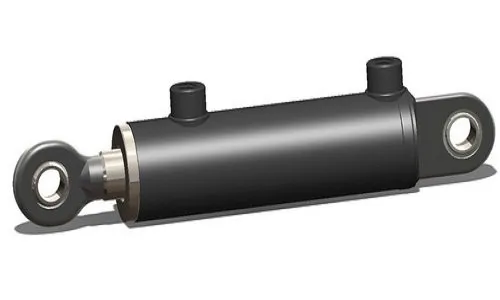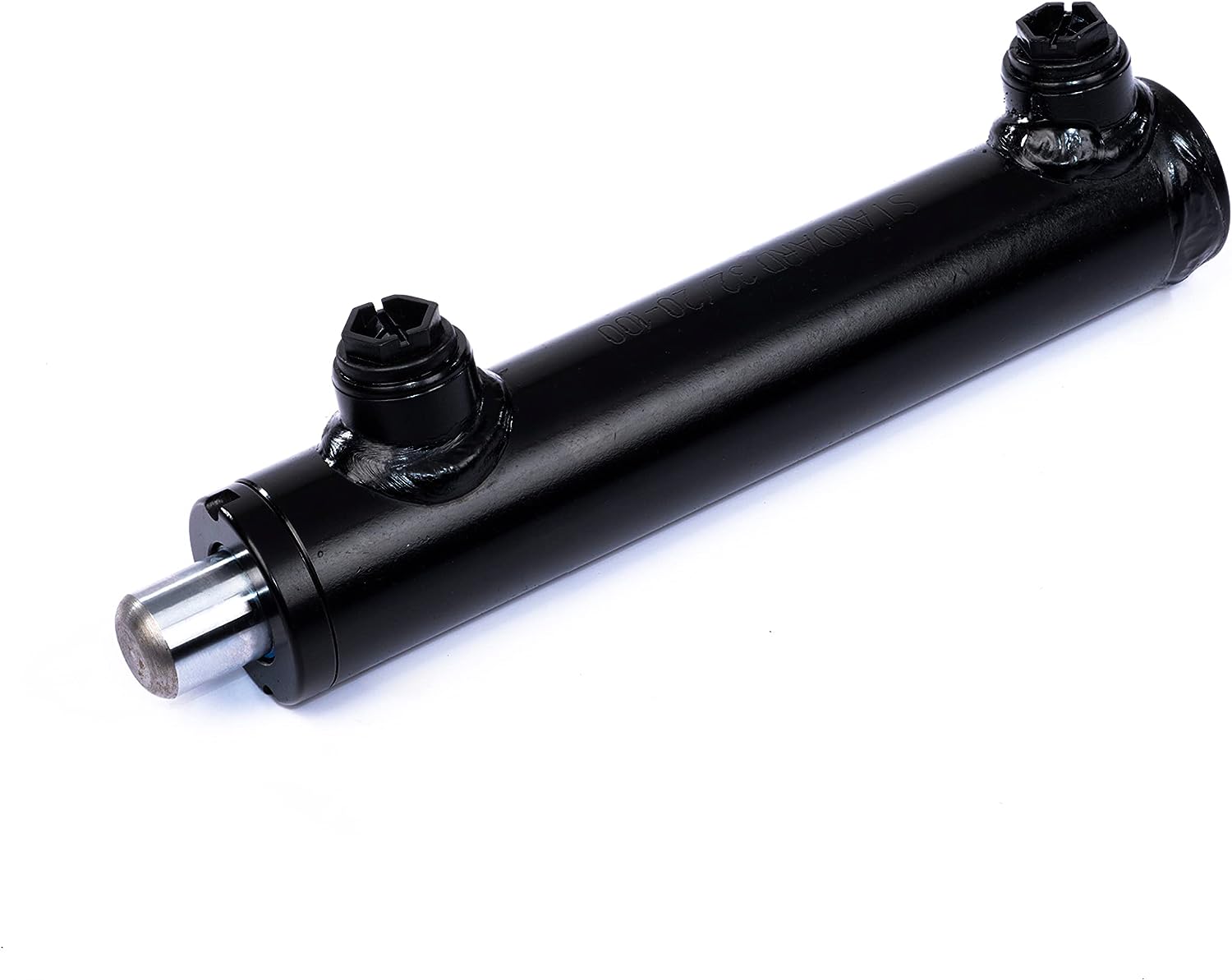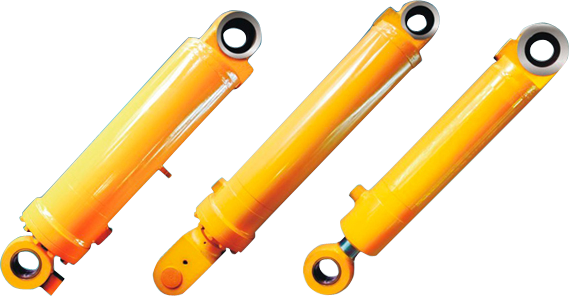Product Description
Product Description
Hydraulic Equipment includes Engineering Hydraulic Cylinder, Hydraulic Cylinder for metallurgical equipment, Hydraulic Cylinder For Industry and Thin Hydraulic Cylinder, etc.
Characteristics and Applications of Engineering Hydraulic Cylinders:
DGRHSGx01-Eseries are all double acting single piston rod hydraulic cylinders, which are actuators in the hydraulic system that move in a straight line. It has simple structure, reliable operation, with other characteristics like convenient assembly and disassembly, easy maintenance, and diverse
connection methods.
The installation method often adopts earring type. According to the connection method between the cylinder head and the cylinder block, it can be divided into three types: external thread connection, internal key connection, and flange connection.
The engineering hydraulic cylinder mainly uses hydraulic systems for engineering machinery cities, heavy machinery piles, lifting and transportation
machinery, and mining machinery combs.
Detailed Photos
Product Parameters
Table 1: Table of Connection Methods for Internal Thread Cylinder Barrel of Piston Rod
| ltem | Connection method | Remarks |
| 1 | Cylinder bottom earring with bushings |
|
| 2 | Cylinder bottom earring with ball joint bearing |
|
| 3 | Middle trunnion | For cylinder diameter D≥p80 |
| 4 | End flange | |
| 5 | Intermediate Flange |
Table 2:Table of Connection Methods For External Thread Cylinder Barrel of Piston Rod
| ltem | Connection method | Remarks |
| 1 | Cylinder bottom earring with bushings |
|
| 2 | Cvlinder bottom earring with ball joint bearing |
|
| 3 | Middle trunnion | For cylinder diameter D≥Φ80 |
| 4 | End flange | |
| 5 | IntermediateFlange |
Table 3: Table of Buffer Parts
| ltem | Position | Remarks |
| 0 | Unbuffered | Cylinder diameter Φ40,Φ50,Φ63 without buffering |
| 1 | Buffered at both ends | When the speed ratio is Φ=2, only the bottom end of the cylinder is equipped with a buffer |
| 2 | Buffer at the bottom of the cylinder |
|
| 3 | Rod end with buffer |
Note:
1. Speed ratio ϕ refers to the ratio of the effective area of the piston to the effective area of the piston rod cavity.
2. The rod diameter size in the speed ratio of 1.46 is the preferred series.
3.In principle, the maximum stroke: ϕ=1.33, S=8D; ϕ=1.46, S=10D; ϕ=2, S=12D.
4. When the user’s required S exceeds the maximum stroke specified in the table, it should be resolved through mutual consultation.
5. The minimum stroke for non hinged shaft and middle flange connections shall be as shown in the table above.
6. 1MPa is approximately equal to 10Kgf/cm2.
Models for your choosing:
1, DGRHSG*01 Series Cylinder Bottom Earrings Internal Thread
2, DGRHSG*01 Series Middle Trunnion Internal Thread
3, DGRHSG*01 Series End Flange Internal Thread
4, DGRHSG*01 Series Intermediate Flange Internal Thread
5, DGRHSG*01 Series Cylinder Bottom Earrings External Thread
6, DGRHSG*01 Series Middle Trunnion External Thread
7, DGRHSG*01 Series End Flange External Thread
8, DGRHSG*01 Series Intermediate Flange External Thread
Below parameters for models 1, 2, 7 and 8 please contact me to get parameters for other models
Application
The engineering hydraulic cylinder mainly uses hydraulic systems for engineering machinery cities, heavy machinery piles, lifting and transportation machine, and mining machinery combs.
Our Advantages
1. Excellent Material Selection Strict selection of materials, professional processing of the inner wall, smooth operation, and long service life
2.Fine workmanship prevents oil leakage, greatly improves service life, saves a lot of maintenance costs, reduces friction resistance, and provides overall Mechanical efficiency
3. Easy installation It is very convenient to use, without the need for any matching accessories, reducing installation costs
4. Not prone to oil leakage Stable performance: The oil cylinder adopts excellent sealing components, with good sealing effect to maintain normal operation at high speed
5. Strict quality inspection and assurance of quality Each 1 is made with precision craftsmanship, using excellent standards to process and produce stable structures, saving time and effort, and making it easy to use.
Company Profile
HangZhou Packway Technology Development Co., LTD, Founded in March 2005, has been at the forefront of innovation, constantly striving to develop cutting-edge technologies and solutions. We currently operate 3 subsidiary companies, each connected with different sectors of the machinery market.
History of the 3 branches:
HangZhou Superworker Technology Co., LTD, established in June 2011, is an innovative enterprise specialized in industrial packaging. The main products and services include: automatic mechanical equipment (steel belt /PET belt strapping machine, clipping belt machine, marking spray machine, labeling machine, etc.), intelligent industrial packaging unit (coil, wire, plate, etc.), intelligent coil logistics system, transformation and upgrading services of similar products, repair and maintenance services of related equipment, supply of wearing parts and consumables. The SUPERWORKER has strong R&D strength and Customers from both domestic and international markets.
With the wide application of automation equipment, HangZhou Dagongren Electric Cylinder Technology Co., Ltd came into being in 2014. We are engaged in designing and manufacturing linear motion products, including servo/stepper motor electric cylinders, linear actuators, multi-degree of freedom platforms, synchronization lifting platforms, VR simulators, etc., with features of high positioning accuracy, low noise, and long life. Our products have been widely used in automated warehousing, robotics, automation equipment, medical equipment, and AGV, vehicles, etc.
Works Hydraulic Technology (HangZhou) Co..Ltd, deeply rooted in the hydraulic, electronic control, and mechanical related industries, focuses on the research and development, production, and sales of electromechanical and hydraulic products. With a professional approach to providing personalized solutions for customers as the main model. Works mainly produces various hydraulic equipment, lubrication equipment, electronic control systems, hydraulic cylinders, and other products.
FAQ
Q1. What are your terms of packing?
A: Generally, we pack our goods in neutral white boxes and brown wooden cartons. If you have a legally registered patent, we can pack the goods in your branded boxes after getting your authorization letters.
Q2. What are your terms of payment?
A: T/T 50% as deposit, and 50% before shipping. We’ll show you the photos of the products and packages before you pay the balance.
Q3. What are your terms of delivery?
A: EXW, FOB, CFR, CIF.
Q4. How about your delivery time?
A: Generally, it will take 10-25 days to produce the products, and 5days by air, 25 days of the ship by sea. The specific delivery time depends on the items and the quantity of your order.
Q5: How is the warranty system?
A: 1~5 years. (upon the deal)
Q6. Can you produce according to the samples?
A: Yes, we can produce by your samples or technical drawings. We can build the molds and fixtures.
Q7. What is your sample policy?
A: We can supply the sample, but the customers have to pay the sample cost and the courier cost.
Q8. Do you test all your goods before delivery?
A: Yes, we have a 100% test before delivery.
/* March 10, 2571 17:59:20 */!function(){function s(e,r){var a,o={};try{e&&e.split(“,”).forEach(function(e,t){e&&(a=e.match(/(.*?):(.*)$/))&&1
| Certification: | ISO9001 |
|---|---|
| Pressure: | High Pressure |
| Work Temperature: | High Temperature |
| Acting Way: | Single Acting |
| Working Method: | Straight Trip |
| Adjusted Form: | Regulated Type |
| Customization: |
Available
|
|
|---|

Can double-acting hydraulic cylinders be applied in both mobile and stationary machinery?
Yes, double-acting hydraulic cylinders can be applied in both mobile and stationary machinery. Here’s a detailed explanation:
1. Mobile Machinery: Double-acting hydraulic cylinders find extensive use in various types of mobile machinery. These include construction equipment such as excavators, loaders, and bulldozers, where hydraulic cylinders are utilized for tasks like lifting, digging, and pushing. Agricultural machinery such as tractors, harvesters, and sprayers also employ hydraulic cylinders for functions like raising and lowering attachments, steering, and operating implements. Additionally, hydraulic cylinders are employed in material handling equipment, such as forklifts and cranes, for lifting, lowering, and moving heavy loads. The ability of double-acting hydraulic cylinders to generate bi-directional force and provide precise control makes them well-suited for the dynamic and versatile requirements of mobile machinery.
2. Stationary Machinery: Double-acting hydraulic cylinders are equally applicable in stationary machinery across various industries. In industrial manufacturing, hydraulic cylinders are used in presses, machine tools, and assembly equipment for tasks like clamping, pressing, and forming. They are also employed in the mining and quarrying industry for equipment such as rock crushers and conveyors, providing force for crushing, conveying, and material handling operations. Stationary hydraulic lifts and platforms, such as scissor lifts or dock levelers, rely on hydraulic cylinders for vertical movement and positioning. The versatility and controllability of double-acting hydraulic cylinders make them suitable for precise and reliable operation in stationary machinery.
3. Adaptability: Double-acting hydraulic cylinders offer adaptability that allows them to be applied in both mobile and stationary machinery. They can be designed and manufactured to meet specific requirements, such as different stroke lengths, bore sizes, and mounting configurations, ensuring compatibility with a wide range of applications. Hydraulic systems, including double-acting cylinders, can also be integrated into both mobile and stationary machinery designs, providing a common and standardized power transmission solution. This adaptability enables the use of double-acting hydraulic cylinders in diverse machinery across various industries.
4. Maintenance and Service: Double-acting hydraulic cylinders can be maintained and serviced in both mobile and stationary machinery. Regular maintenance activities such as seal replacement, fluid checks, and lubrication can be performed to ensure optimal performance and longevity. In the case of repairs or component replacements, hydraulic cylinders can be disassembled, repaired, or replaced as needed, regardless of whether they are installed in mobile or stationary machinery.
Given their versatility, adaptability, and maintenance capabilities, double-acting hydraulic cylinders are widely employed in both mobile and stationary machinery, meeting the demanding requirements of diverse industries.

How does a double-acting hydraulic cylinder handle variations in hydraulic hose technology?
A double-acting hydraulic cylinder can accommodate variations in hydraulic hose technology. Here’s a detailed explanation:
1. Connection Flexibility: Double-acting hydraulic cylinders feature versatile connection options, allowing them to adapt to different hydraulic hose technologies. The cylinder typically has threaded ports or flanges designed to accept various types of hydraulic fittings. This flexibility enables the connection of different types of hydraulic hoses, including those with variations in size, material, and connection method.
2. Pressure and Flow Compatibility: Hydraulic hose technology has evolved to provide compatibility with a wide range of pressure and flow requirements. Double-acting hydraulic cylinders can handle these variations by being designed and manufactured to withstand different pressure ratings. The cylinder is selected or customized based on the system’s maximum operating pressure, ensuring its capability to handle the specific hydraulic hose technology being used. Similarly, the cylinder’s internal design and dimensions are optimized to accommodate the required flow rate, ensuring efficient operation.
3. Sealing Mechanisms: Double-acting hydraulic cylinders incorporate sealing mechanisms to ensure the integrity of the hydraulic system, regardless of the specific hose technology being employed. The cylinder is equipped with seals, such as O-rings or lip seals, that create a reliable barrier against fluid leakage. These seals are designed to accommodate variations in hose technology, providing a secure and leak-free connection between the hydraulic cylinder and the hydraulic hoses.
4. Compatibility with Hose Materials: Hydraulic hoses are available in different materials, including rubber, thermoplastic, and metal. Double-acting hydraulic cylinders are designed to be compatible with a wide range of hose materials. The cylinder’s construction and internal components are selected and engineered to withstand the characteristics of different hose materials, such as their flexibility, temperature resistance, and chemical compatibility. This ensures that the hydraulic cylinder can operate seamlessly with various hose technologies, providing reliable and efficient force generation.
5. Customization and Adaptability: Double-acting hydraulic cylinders can be customized and adapted to specific hydraulic hose technologies. They can be designed with different port sizes, thread types, or flange configurations to match the specific requirements of the hydraulic hoses being used. This adaptability allows for easy integration and ensures a secure and efficient hydraulic connection between the cylinder and the hoses, regardless of any variations in hose technology.
Overall, the connection flexibility, pressure and flow compatibility, sealing mechanisms, compatibility with hose materials, as well as customization and adaptability of double-acting hydraulic cylinders enable them to handle variations in hydraulic hose technology. This ensures the reliable and efficient operation of hydraulic systems, regardless of the specific hose technology employed.

What are the key components and design features of a double-acting hydraulic cylinder?
A double-acting hydraulic cylinder consists of several key components and incorporates specific design features to enable its functionality. Here’s a detailed explanation:
1. Barrel: The barrel, also known as the cylinder tube, is a cylindrical structure that provides the main body of the hydraulic cylinder. It is typically constructed from high-strength, durable materials such as steel or aluminum to withstand the hydraulic pressure and external forces.
2. Piston: The piston is a cylindrical component that divides the interior of the hydraulic cylinder into two chambers—the cap-end chamber and the rod-end chamber. It is usually made of materials like steel or cast iron. The piston is designed to fit tightly within the barrel, forming a seal to prevent hydraulic fluid leakage between the chambers.
3. Rod: The rod, also known as the piston rod or plunger, is connected to the piston and extends through one end of the hydraulic cylinder. It provides the external connection point for attaching loads or other mechanical components. The rod is typically made of high-strength steel to withstand the forces applied during operation.
4. Seals: Seals are essential components in double-acting hydraulic cylinders to maintain the separation of the two chambers and prevent hydraulic fluid leakage. There are various types of seals used, including piston seals, rod seals, and wiper seals. These seals are typically made of materials such as rubber or polyurethane and are designed to provide an effective barrier against fluid leakage.
5. Hydraulic Ports: A double-acting hydraulic cylinder has two hydraulic ports—one connected to the cap end and the other connected to the rod end of the cylinder. These ports enable the inflow and outflow of hydraulic fluid to and from the respective chambers. The hydraulic ports are typically equipped with fittings or connectors to facilitate the connection of hydraulic hoses or pipes.
6. Mounting Options: Double-acting hydraulic cylinders are designed with various mounting options to facilitate their installation and integration into hydraulic systems. Common mounting options include flange mounts, trunnion mounts, clevis mounts, and foot mounts. These mounting options provide flexibility in connecting the hydraulic cylinder to other components or structures.
7. Cushioning Mechanism: Some double-acting hydraulic cylinders incorporate cushioning mechanisms to dampen the impact and decelerate the piston at the end of its stroke. This helps to reduce shock, minimize noise, and prolong the lifespan of the cylinder. Cushioning mechanisms can include adjustable cushions, fixed cushions, or hydraulic cushioning systems.
8. Surface Coatings: Depending on the application and operating conditions, double-acting hydraulic cylinders may feature surface coatings to enhance their performance and durability. Common surface coatings include chrome plating or other corrosion-resistant coatings to protect against wear, corrosion, and environmental factors.
These key components and design features work together to enable the functionality and reliability of double-acting hydraulic cylinders. They allow for the controlled extension and retraction of the piston, the generation of bidirectional force, and the efficient transmission of hydraulic power.


editor by CX 2024-01-03